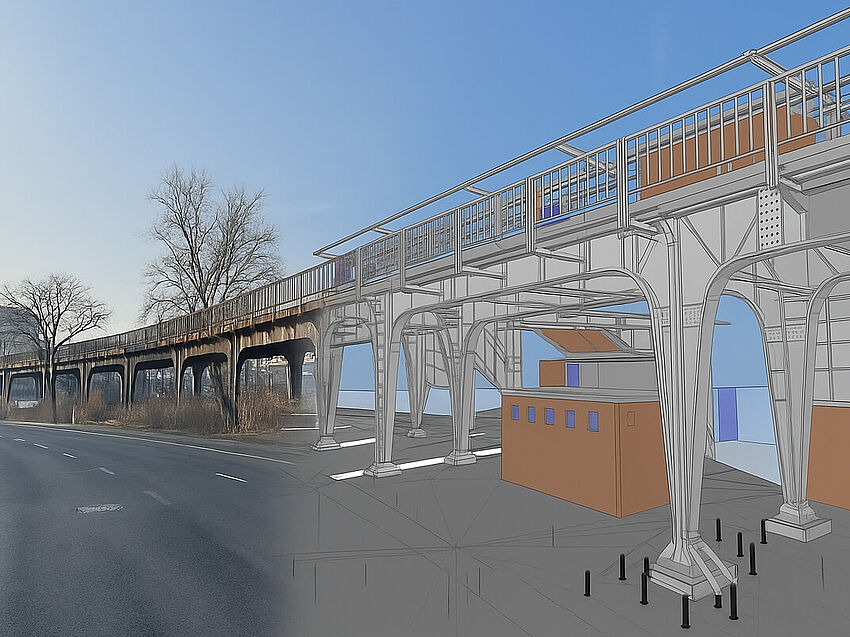Reactivation of the Siemensbahn: KREBS+KIEFER relies on ALLPLAN
Large infrastructure projects are different from other building projects, mainly due to their scale, complexity, and lengthy timeframes. Coordinating these extensive projects can be a challenge, particularly across the multiple teams that are likely to be involved. However, Building Information Modeling (BIM) can help resolve some of these issues by facilitating a collaborative environment. BIM for infrastructure helps ensure that the design, construction, and management of large-scale infrastructure projects is much more efficient, accurate, and timely compared to traditional delivery methods – here’s why.
The Unique Challenges of Large Infrastructure Projects
All construction projects face similar challenges – disparate teams, budget and time constraints, and scope changes. However, because of the size of large infrastructure projects, these challenges are magnified. For example, the resulting design and construction schedules required for these types of projects are longer than simpler builds. In turn, there can be additional changes as the project evolves over the lifetime of the project, which can span several years. Every change requires new drawings and approvals from a number of stakeholders, and often this process is repeated multiple times throughout the project duration.
While every project typically involves a number of different stakeholders, the complexity and scale of large infrastructure projects means that this number is significantly increased. Managing the large number of teams and disciplines involved requires efficient collaboration, which can be difficult to manage using traditional communication and 2D approaches. Each of these disciplines will use their own specialist software for their section of the works, which may not be compatible with other teams’ software. Therefore, sharing information amongst the team members can be difficult and time-consuming if the information needs re-creating in another 3D CAD program.
The Benefits of BIM for Infrastructure Projects
BIM helps overcome these issues for efficient, collaborative, and successful project delivery. While it is most often associated with precise 3D modeling, it is really a working methodology and has other benefits beyond being an enhanced drawing and design tool.
A Common Data Environment
One of the major benefits of BIM for infrastructure is that it should facilitate a common data environment (CDE). For example, using a model CDE let’s all disciplines work from the same model, while ensuring everyone is using the most current version. It also helps with managing project documentation, which can become onerous due to the large volume of information generated over the project’s lifespan. A CDE can help automate this process by having a single source of truth that is kept consistent across all team inputs.
Seamless Data Exchange
Open BIM is a universal standard that supports the manufacturer-neutral exchange of data between different BIM software tools. An open BIM platform, such as Bimplus by ALLPLAN uses IFC to democratize data through the import of files or data generated by other programs, without losing information. This removes the need for different teams to all use the same software package in order to collaborate effectively. Every discipline can use the software of their choice to create their element of the works, while still being able to have their section seamlessly incorporated into the complete project model.
Clash Detection and Change Management
With BIM, detecting clashes is much easier than using 2D drawing methods and relying on visual inspections. The visualization that a 3D model enables makes it much easier for all parties to understand how their element of the works fits into the larger picture. In addition, with everyone working from the same, up-to-date model status, there are no inadvertent clashes created by using an outdated version. It also makes scope changes much easier to manage and implement, as the impact of any change is immediately available to all parties and any collisions highlighted in the software, which constantly monitors the structural integrity of the model. This ensures errors are rectified before they are discovered on site, which wastes valuable time, money, and materials.
BIM for Infrastructure in Practice
Infrastructure megaprojects are essential for meeting needs for transportation and utilities, so it is critical that their design and execution ensures long-term viability and safety. In theory, BIM for infrastructure projects promises many advantages. However, how does this work in the real world? Landmark infrastructure projects such as the Gotthard Base Tunnel in the Swiss Alps, the Grubental Railway Bridge in central Germany, or the Stuttgart 21 metro project in Southern Germany have all used BIM to overcome challenges that would have been impossible to manage with standard 2D drawing methods. Learn how they benefited from sophisticated BIM solutions from ALLPLAN in our whitepaper.




